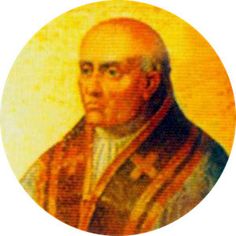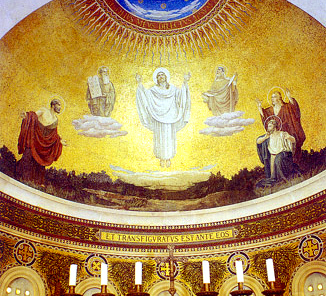
August 6th – The Transfiguration of the Lord – Years ABC
A reading from the Gospel according to Matthew 17:1-9

Jesus took with him Peter and James and his brother John and led them up a high mountain where they could be alone. There in their presence he was transfigured: his face shone like the sun and his clothes became as white as the light. Suddenly Moses and Elijah appeared to them; they were talking with him.
Then Peter spoke to Jesus.
‘Lord,’ he said ‘it is wonderful for us to be here; if you wish, I will make three tents here, one for You, one for Moses and one for Elijah.’
He was still speaking when suddenly a bright cloud covered them with shadow, and from the cloud there came a voice which said,
‘This is my Son; the Beloved; he enjoys my favour. Listen to him.’
When they heard this, the disciples fell on their faces, overcome with fear. But Jesus came up and touched them. ‘Stand up,’ he said ‘do not be afraid.’ And when they raised their eyes they saw no one but only Jesus.
As they came down from the mountain Jesus gave them this order,
‘Tell no one about the vision until the Son of Man has risen from the dead.’
*********************************
This weekend we have two guest writers as commentators
Fr Rodney Kissinger, S.J
and Paddy Duffy.
1. Fr Rodney Kissinger, S.J
 There is always something awe-inspiring about mountains. On the top the air is clean and crisp. The panoramic view of the surrounding country-side lifts us from the hustle and bustle of the rat-race, and raises our mind and heart to God.
There is always something awe-inspiring about mountains. On the top the air is clean and crisp. The panoramic view of the surrounding country-side lifts us from the hustle and bustle of the rat-race, and raises our mind and heart to God.
The top of a mountain is a natural place for encountering God. It is small wonder then that in the Bible God often chooses a mountain top to reveal Himself and His plans. It was on Mount Sinai that God gave the Ten Commandments to Moses. Jesus gave his first teachings in the Sermon on the Mount. He often retired to the mountain at night to pray. He was crucified on Mount Calvary and ascended to heaven from Mount Olivet.
In today’s Gospel Jesus is Transfigured before his apostles on Mount Tabor. Peter, James and John are with him. And they will be with him in the agony of the garden. This will be a preparation for that ordeal. Moses and Elijah are also present speaking with Jesus about his approaching death. Moses is the great law giver and Elijah the great prophet. In the presence of these two, representing the law and the prophets the voice of the Father is heard, “This is my beloved son listen to him.” Slowly, the transition from the Old Covenant to the New Covenant is taking place.
Jesus came not to destroy the law and the prophets but to bring them to completion. Christianity is not to be an abstract creed or code but a Person. Jesus Christ, true God and true man is to be “the way, the truth and the life.” We are to listen to Him and follow Him. The Epistle to the Hebrews tells us that “In times past God spoke to us through the prophets…but in these last days through his Son.”
For Jesus the Transfiguration was the turning point in his life. Until now all was onward and upward. He was captivating the people with his preaching and miracles. Now he must descend to the valley, to the road to Gethsemane and Calvary. The Transfiguration gave Jesus a foretaste of his glory, and in the strength of that joy he could endure the cross and despise the shame. But most of all the Transfiguration gave Jesus another affirmation of his Father’s love. At His baptism in the Jordan his Father had affirmed him, “This is my beloved Son on whom my favor rests.” Now he says, “This is my beloved son, listen to him.”
For the apostles it was an awe-inspiring experience. They had never seen their master like this before. Peter, filled with consolation says, “Lord, it is good for us to be here. Let us erect three booths here, one for you, one for Moses, and one for Elijah.” But it is not to be. This is only a preparation for things to come. With Jesus they must descend the mountain to the valley below and on to the garden of Gethsemane and Calvary. On Mount Tabor they didn’t want to leave. In the Garden of Gethsemane they didn’t want to stay. When Jesus was arrested they all fled.
We can all identify with the apostles because in our mountain-top experiences of joy and consolation we also want to stay. We want them to go on forever. And then in the moments of trial we want to flee. We forget that our Lord did not promise us a rose garden, but a garden of olives and a crown of thorns. “If anyone will come after me let him pick up his cross daily and follow me.”
The Transfiguration was the mountain-top experience of the apostles which prepared them for their future trials. The Mass is our mountain-top experience which prepares us for the trials of our day. The Mass is not a transfiguration but a transubstantiation, in which bread and wine are transformed into the glorious Risen Jesus. And in the joy and consolation of Communion we say with Peter, “Lord, it is good for us to be here.” And we do not want to leave. But it is not to be. Soon we will hear the words, “The Mass is ended. Go in peace to love and serve the Lord.” So we pick up our cross and leave to face the trials of the day. But having been to the top of the mountain we know that “nothing can separate us from the love of God made visible in Christ Jesus our Lord.”
2. Paddy Duffy a former member of our staff offers writes:
The date for this feast – 6th August – seems to have been chosen in order to be exactly forty days before 14th September, the Feast of the Exaltation of the Holy Cross, because of a tradition that the Transfiguration took place forty days before the crucifixion. This feast began to be celebrated in and around Jerusalem in the fourth and fifth centuries.
A Major Feast at Constantinople
The feast probably reached Constantinople during the time of the great hymn-writer Andrew of Crete (c. 660-740), who was a monk at the Church of the Holy Sepulchre from 675 until 685, when he moved to serve at the Great Church of Sancta Sophia, Constantinople. Later he became Archbishop of Gortyna in Crete. It was a major feast, which developed a magnificent series of hymns and readings.
Spain, Cluny and Rome

Callixtus III, Papa ; 8 /4/1455 – 6 /8/1458
The feast appeared in the West, first in Spain in the eleventh century, then at Cluny, when Peter the Venerable was abbot (1122-56). Its introduction to Rome is associated with the Christian defeat of the Turks at Belgrade on 22 July 1456. The news reached Rome on 6th August, so Pope Callixtus III (Alfons de Borja 1455-8), a Valencian sensitive to the memory of Moorish domination in Spain, decreed it as a feast for the Roman Church beginning on 6th August 1457.
Gospel Accounts
All three synoptic Gospels – Mark, Matthew, and Luke – give us an account of the Transfiguration of Jesus on top of Mount Tabor (Mark 9:1-8, Matthew 17:1-6, Luke 9:28-36). After Peter’s confession of faith in Jesus as the Messiah, the One sent by God to redeem mankind, and Jesus prediction of His own passion and death, Jesus, together with three of His disciples – Peter, James, the son of Zebedee, and John – went up the mountain.
Moses and Elijah
Matthew says Jesus “was transfigured before them. His face shone as the sun: his garments became white as snow“. Two other figures appeared with Him: Moses and Elijah. Christ thus stood between the two prominent figures in the Old Testament. Then, a voice was heard from above saying,
“This is My Son, the Beloved; with him I am well pleased; listen to him.”
 Significance
Significance
Jesus ordered the three not to tell others what they had seen until he had risen on the third day. Even if they did not fully comprehend what had happened on Mount Tabor, for the apostles Peter, James, and John, it was a glimpse of the glories of heaven and of sharing in the resurrection of Christ promised to all who believe in Jesus as the One promised by God. That event served as an inspiration for them to persevere and be steadfast in their faith in Jesus who would suffer and die but would be resurrected after three days.
Symbol and Hope of Glory
Jesus’s transfiguration is the symbol and hope of our glory in heaven. For us celebrating the Feast of the Lord’s Transfiguration today – we hope it will give us some foretaste of our own final Easter.